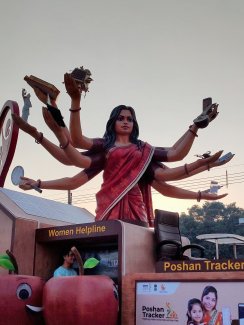Artikkelit

19.02.2025
Indian Women and Girls Are Interested in Science – Entering the Workforce and Academia Is a Challenge
India has a high percentage of female enrollment in STEM (science, technology, engineering, and mathematics) fields compared to most other countries. In India, 42.5 percent of STEM students are women, while in the EU the figure is only around 30 percent. However, women represent only 27 percent of India’s STEM workforce and just 16 percent of academic faculty positions. Various societal and cultural issues discourage Indian women from pursuing a career in science.
Female Labour Force Participation in India Is Low, but Rising
The generally low participation rate of women in work life has long been a problem in India. In 2018, the female labour force participation rate (FLFPR) was only 23.3%, very low compared to the global average of 53% and the 75% of Indian men. Traditional social norms that expect women to stay at home, especially after marriage, still have a significant impact on many women’s career possibilities in India. However, the FLFPR has been rising rapidly in the past years. In September 2024, the rate had already risen to over 40%. Part of the rise may be explained by changes in measurement, but also by an increased entrepreneurship among rural women. Their work typically includes low-paid help in family farms and tasks such as selling vegetables and other products outside home. The Indian government has supported rural entrepreneurship with microfinance schemes, and women are the ones taking advantage of such opportunities.
Although the female labour force participation rate has risen significantly in the past years, it remains low, especially in urban areas. In order to achieve its target of becoming a developed economy by 2047, the participation rate of women in India has to double. Unleashing the unused talent and potential of hundreds of millions of women is also a great opportunity for India.
Reaching the Top Positions Is Still Difficult for the Increasing Number of Women in Higher Education
When it comes to the representation of women in higher education, the numbers are much more positive. According to the latest All India Survey on Higher Education report, females constitute 48% of the total number of students in higher education. In the STEM fields where women are globally underrepresented, women account for 42.5 % of the students in India. This figure is higher than in most EU countries or the US. Still, old stereotypes and prejudices about women’s suitability for careers in STEM persist in India, as they do worldwide.
Unfortunately, the relatively high number of Indian women in STEM fields and higher education in general does not translate into the workforce and academic careers. In STEM fields, only 27% of the workforce are women. In academia, overall, less than 30% of the professors are women, and in the STEM fields, women account for only 16 % of all the academic faculty positions. Career gaps and dropouts due to marriage and pregnancy, in addition to discrimination in the selection processes, are some of the main causes for women’s underrepresentation in academic careers. However, as the number of women in higher education continues to rise, the proportion of women in higher academic positions is also expected to increase.
The Indian Government is well aware of the challenges women face especially in the STEM fields. The Department of Science and Technology (DST) has various programs aimed at increasing the number of girls and women in STEM fields. For example, a program called “Vigyan Jyoti” aims to provide support to girls interested in STEM, all the way from school level to PhD. The program includes activities such as science camps, visits, and counseling in order to motivate girls to continue their studies in the STEM fields. Other programs, such as WISE-KIRAN, provide fellowships specifically aimed at women who have had breaks in their scientific career due to family responsibilities. However, apart from governmental support, a significant change in the attitudes and beliefs is required so that more women can reach the top academic positions in India.
The Dreams and Careers of Women in Science
For the 10th International Day of Women and Girls in Science, celebrated on 11 February 2025, the Team Finland Knowledge network launched a series of global dialogues to promote the role of women and girls in science. At a video campaign organized by the Embassy of Finland in New Delhi, the stage was given to four inspiring Indian female scientists at different stages of their careers. Romalin Bal, Khushboo Nagal, Ketki Kulkarni, and Anuradha T.K shared their dreams, passions and aspirations, and gave an empowering message to all the Indian girls aiming to become scientists.
Text: Joel Hakala, TFK Intern, Embassy of Finland in New Delhi.
Photos: Joel Hakala and Liisa Toivonen.
